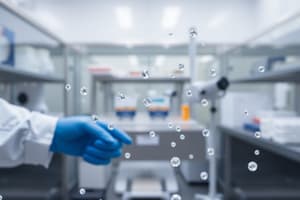Podcast
Questions and Answers
Which element is the main constituent of a cell?
Which element is the main constituent of a cell?
- Oxygen
- Carbon (correct)
- Nitrogen
- Hydrogen
From which source do heterotrophs obtain carbon?
From which source do heterotrophs obtain carbon?
- Organic molecules (correct)
- Light
- Reduced inorganic compounds
- CO2
What is the function of iron in a bacterium?
What is the function of iron in a bacterium?
- Nucleic acids and nucleotides
- Main inorganic cations and enzymatic cofactor
- Cytochrome component and enzymatic cofactor (correct)
- Proteins and several coenzymes
Which element is the electron acceptor in aerobic respiration?
Which element is the electron acceptor in aerobic respiration?
From which source do lithotrophs obtain electrons?
From which source do lithotrophs obtain electrons?
What is the primary source of potassium for a bacterium?
What is the primary source of potassium for a bacterium?
What is the primary purpose of using solid media (agar plates) for culturing microorganisms?
What is the primary purpose of using solid media (agar plates) for culturing microorganisms?
What is the main difference between undefined media and defined media for microorganism culture?
What is the main difference between undefined media and defined media for microorganism culture?
Which method is used for anaerobic culture by producing CO2 and H2 from breakdown of citric acid, cobalt chloride, and sodium borohydride?
Which method is used for anaerobic culture by producing CO2 and H2 from breakdown of citric acid, cobalt chloride, and sodium borohydride?
Which type of microorganism can tolerate oxygen in the air but produces energy by fermentation?
Which type of microorganism can tolerate oxygen in the air but produces energy by fermentation?
What is the main characteristic of bacterial growth during the exponential (log) phase?
What is the main characteristic of bacterial growth during the exponential (log) phase?
What is the primary purpose of secondary metabolism in microbial cells?
What is the primary purpose of secondary metabolism in microbial cells?
Which method aims to remove or kill all microorganisms and infectious proteins?
Which method aims to remove or kill all microorganisms and infectious proteins?
What type of infection is characterized by minor infections that do not spread beyond the site of injection or contact?
What type of infection is characterized by minor infections that do not spread beyond the site of injection or contact?
Which process involves the series of operations to purify and sterilize medical products, reducing the risk of contamination and side effects?
Which process involves the series of operations to purify and sterilize medical products, reducing the risk of contamination and side effects?
What is the most serious effect that can come from contaminated injectable products?
What is the most serious effect that can come from contaminated injectable products?
Which method involves the process of separating products from production mixtures and removing unwanted components?
Which method involves the process of separating products from production mixtures and removing unwanted components?
What is the main purpose of downstream processing?
What is the main purpose of downstream processing?
Which method is important for minimizing microbial contamination while minimizing product damage?
Which method is important for minimizing microbial contamination while minimizing product damage?
What can result from contamination of injectable products with toxic microbial metabolites?
What can result from contamination of injectable products with toxic microbial metabolites?
What is an example of a recognized sterilization method by European Pharmacopoeia(2002)?
What is an example of a recognized sterilization method by European Pharmacopoeia(2002)?
What is the process of separating products from production mixtures and removing unwanted components using methods such as sedimentation, precipitation, centrifugation, adsorption, and filtration?
What is the process of separating products from production mixtures and removing unwanted components using methods such as sedimentation, precipitation, centrifugation, adsorption, and filtration?
What type of infection is often caused by ingestion of contaminated products?
What type of infection is often caused by ingestion of contaminated products?
Which method involves the use of methods such as heat, filtration, and radiation to remove or kill all microorganisms and infectious proteins?
Which method involves the use of methods such as heat, filtration, and radiation to remove or kill all microorganisms and infectious proteins?
Which type of contamination is not mentioned in the text?
Which type of contamination is not mentioned in the text?
What is one of the sources of biological contamination mentioned in the text?
What is one of the sources of biological contamination mentioned in the text?
Which type of area is used for clean or aseptic preparation in controlling microbial contamination?
Which type of area is used for clean or aseptic preparation in controlling microbial contamination?
What is used for environmental controls in aseptic production as mentioned in the text?
What is used for environmental controls in aseptic production as mentioned in the text?
What type of water has stricter quality guidelines than purified water as per the text?
What type of water has stricter quality guidelines than purified water as per the text?
What is a common source of microbial contamination from personnel mentioned in the text?
What is a common source of microbial contamination from personnel mentioned in the text?
What method is used for product sampling and clinical samples as per the text?
What method is used for product sampling and clinical samples as per the text?
Which standard is mentioned in the text for regulating contamination?
Which standard is mentioned in the text for regulating contamination?
What are the potential consequences of microbial contamination according to the text?
What are the potential consequences of microbial contamination according to the text?
What method is used for liquid sampling according to the text?
What method is used for liquid sampling according to the text?
In which area are environmental controls maintained for aseptic production?
In which area are environmental controls maintained for aseptic production?
Which method of sterilization is generally reserved for temperature sensitive items such as reusable surgical instruments and medical diagnostic equipment?
Which method of sterilization is generally reserved for temperature sensitive items such as reusable surgical instruments and medical diagnostic equipment?
What is the assumed mechanism of action for broad spectrum antimicrobials used in sterilization?
What is the assumed mechanism of action for broad spectrum antimicrobials used in sterilization?
Which type of radiation used for sterilization requires the facility to be heavily shielded and can damage some materials due to radiolysis of water?
Which type of radiation used for sterilization requires the facility to be heavily shielded and can damage some materials due to radiolysis of water?
What is the primary target of both ionising and non-ionising radiation used for sterilization?
What is the primary target of both ionising and non-ionising radiation used for sterilization?
How can sterilization be checked to ensure its success?
How can sterilization be checked to ensure its success?
What is the purpose of using biological indicators during sterilization?
What is the purpose of using biological indicators during sterilization?
According to sterility assurance, what does 'sterile' mean?
According to sterility assurance, what does 'sterile' mean?
What is the microbial safety index aiming for in terms of probability?
What is the microbial safety index aiming for in terms of probability?
What method is used as the primary choice for assessing whether a sterilized product is free from microbial contamination by incubating a sample in nutrient medium?
What method is used as the primary choice for assessing whether a sterilized product is free from microbial contamination by incubating a sample in nutrient medium?
What can happen when sterility testing indicates that a sterilized product is not free from microbial contamination?
What can happen when sterility testing indicates that a sterilized product is not free from microbial contamination?
What does achieving true sterility entail based on microbial safety index probability?
What does achieving true sterility entail based on microbial safety index probability?
What will have a direct impact on the success of sterilization, according to the text?
What will have a direct impact on the success of sterilization, according to the text?
Which type of culture allows for controlled growth with constant nutrient supply?
Which type of culture allows for controlled growth with constant nutrient supply?
What are the three growth modes for bulk culturing?
What are the three growth modes for bulk culturing?
What is an important criterion for scaling up production?
What is an important criterion for scaling up production?
What does viral replication rely on?
What does viral replication rely on?
What can bacterial evolution result from?
What can bacterial evolution result from?
What results from bacterial evolution and selective pressure from antibiotics?
What results from bacterial evolution and selective pressure from antibiotics?
What is strain improvement aimed at achieving?
What is strain improvement aimed at achieving?
What is the process of producing human-identical insulin through cloning and gene modification in E. coli called?
What is the process of producing human-identical insulin through cloning and gene modification in E. coli called?
What mechanism does bacterial evolution include?
What mechanism does bacterial evolution include?
What can contamination of pharmaceutical products lead to?
What can contamination of pharmaceutical products lead to?
What does lab-scale culture optimize steps for?
What does lab-scale culture optimize steps for?
What can some viruses do during replication?
What can some viruses do during replication?
Flashcards are hidden until you start studying
Study Notes
- Pyocyanin: produced in batch and continuous laboratory-scale cultures
- Batch culture: limited nutrient availability and product production due to closed systems
- Continuous culture: open systems, allows for controlled growth with constant nutrient supply
- Scaling up production: bulk culturing, three growth modes: batch, fed batch, and continuous
- Important criteria: maintain adequate mixing, high oxygen levels, control pH, temperature, and foam
- Viral replication: relies on host cell machinery, can lead to cell destruction or budding
- Bacterial evolution: changes in population over time due to mutation or DNA acquisition
- Antimicrobial resistance: results from bacterial evolution, selective pressure from antibiotics
- Strain improvement: increase production through spontaneous or targeted mutations, genetic modification
- Heterologous gene expression: production of human-identical insulin through cloning and gene modification in E. coli
Additional bullet points:
- Lab-scale culture: optimizes steps for product production, limited in industrial applications
- Viral replication: can lead to human disease, some viruses integrate into host genome
- Bacterial evolution: mechanisms include transformation, transduction, and conjugation
- Antimicrobial resistance: can lead to increased resistance in bacteria, decreased effectiveness of treatments
- Contamination of pharmaceutical products: understanding origins, reducing risks, testing and results.
Studying That Suits You
Use AI to generate personalized quizzes and flashcards to suit your learning preferences.




